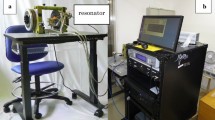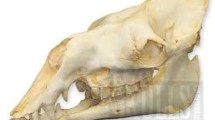Abstract
Large-scale triage after major radiological events, such as nuclear reactor accidents, requires a method of ionizing radiation dose estimation called retrospective biodosimetry (RBD) to detect doses in the range of 0.5–8 Gy. A well-known technique for performing RBD is electron spin resonance (ESR), which can be used to measure radiation-induced paramagnetic defects in the enamel of the teeth. The concentration of these defects is linearly correlated with radiation doses in the applicable range. Despite its great potential and proven results when applied to extracted teeth, ESR still struggles to provide accurate in vivo readings. This is mainly because all available ESR-based RBD methods rely on quantitative signals for calculating the concentration of paramagnetic defects in tooth enamel to evaluate the dose. This requires an accurate knowledge of the volume of the measured enamel, which is very difficult to achieve in live subjects (since teeth also include dentin and possibly cavities). Here, we examine radiation-induced paramagnetic defects in the enamel layer of human teeth using advanced pulsed ESR methods, with the ultimate goal of supporting the development of an innovative practical RBD device for in vivo use. We employ a variety of pulsed ESR techniques, such as ESR measurements of spin–spin relaxation time (T2), ESR monitoring of instantaneous diffusion decay time (TID), and dipolar ESR spectroscopy, to explore their possible use to quantify the irradiation dose. Moreover, we develop a special resonator for teeth measurements that make use of such pulse techniques to overcome the constrains of small signal magnitudes and short coherence times. Our results show a good correlation between measured values of T2, TID, and the irradiated dose, but further work is required to improve the robustness, accuracy, and sensitivity of the methods presented before they could possibly be applied for in vivo measurements in typical doses of ~ 2–8 Gy. These findings and approaches may be used in the future for the development of a RBD device to evaluate ionizing radiation doses without prior knowledge of the measured enamel volume.











Similar content being viewed by others
References
M. Port, M. Majewski, M. Abend, Radiation dose is of limited clinical usefulness in persons with acute radiation syndrome. Radiat. Prot. Dosim. 186, 126–129 (2019)
H.M. Swartz, B.B. Williams, R.J. Nicolalde, E. Demidenko, A.B. Flood, Overview of biodosimetry for management of unplanned exposures to ionizing radiation. Radiat Meas 46, 742–748 (2011)
IAEA, Diagnosis and treatment of radiation injuries. Saf. Rep. Ser. 2, 34–39 (1998)
J.E. Moulder, Post-irradiation approaches to treatment of radiation injuries in the context of radiological terrorism and radiation accidents: A review. Int. J. Radiat. Biol. 80, 3–10 (2004)
H.M. Swartz, A.B. Flood, R.M. Gougelet, M.E. Rea, R.J. Nicolalde, B.B. Williams, A critical assessment of biodosimetry methods for large-scale incidents. Health Phys. 98, 95–108 (2010)
H.M. Swartz, B.B. Williams, B.I. Zaki, A.C. Hartford, L.A. Jarvis, E.Y. Chen, R.J. Comi, M.S. Ernstoff, H.G. Hou, N. Khan, S.G. Swarts, A.B. Flood, P. Kuppusamy, Clinical EPR: Unique opportunities and some challenges. Acad. Radiol. 21, 197–206 (2014)
A.B. Flood, H.K. Boyle, G. Du, E. Demidenko, R.J. Nicolalde, B.B. Williams, H.M. Swartz, Advances in a framework to compare bio-dosimetry methods for triage in large-scale radiation events. Radiat. Prot. Dosim. 159, 77–86 (2014). (PMC4067227)
N. Dainiak, J. Albanese, M. Kaushik, A.S. Balajee, A. Romanyukha, T.J. Sharp, W.F. Blakely, Concepts of operations for a US dosimetry and biodosimetry network. Radiat. Prot. Dosim. 186, 130–138 (2019)
E.H. Haskell, R.B. Hayes, G.H. Kenner, Improved accuracy of EPR dosimetry using a constant rotation goniometer. Radiat. Meas. 27, 325–329 (1997)
IAEA, Use of electron paramagnetic resonance dosimetry with tooth enamel for retrospective dose assessment. IAEA Publ. 57, 1331 (2002)
G. Liidja, A. Wieser, Electron paramagnetic resonance of human tooth enamel at high gamma ray doses. Radiat. Prot. Dosim. 101, 503–506 (2002)
H. Wolfson, R. Ahmad, Y. Twig, B. Williams, A. Blank, A magnetic resonance probehead for evaluating the level of ionizing radiation absorbed in human teeth. Health Phys. 108, 326–335 (2015)
H.M. Swartz, H.G. Hou, N. Khan, L.A. Jarvis, E.Y. Chen, B.B. Williams, P. Kuppusamy, Advances in probes and methods for clinical EPR oximetry. Oxyg. Transp. Tissue 812, 73–79 (2014)
H.M. Swartz, A.B. Flood, B.B. Williams, R.H. Dong, S.G. Swarts, X.M. He, O. Grinberg, J. Sidabras, E. Demidenko, J. Gui, D.J. Gladstone, L.A. Jarvis, M.M. Kmiec, K. Kobayashi, P.N. Lesniewski, S.D.P. Marsh, T.P. Matthews, R.J. Nicolalde, P.M. Pennington, T. Raynolds, I. Salikhov, D.E. Wilcox, B.I. Zaki, Electron paramagnetic resonance dosimetry for a large-scale radiation incident. Health Phys. 103, 255–267 (2012)
B.B. Williams, R.H. Dong, A.B. Flood, O. Grinberg, M. Kmiec, P.N. Lesniewski, T.P. Matthews, R.J. Nicolalde, T. Raynolds, I.K. Salikhov, H.M. Swartz, A deployable in vivo EPR tooth dosimeter for triage after a radiation event involving large populations. Radiat. Meas. 46, 772–777 (2011)
B. Pass, J.E. Aldrich, Dental enamel as an in vivo radiation dosimeter. Med. Phys. 12, 305–307 (1985)
R. Grun, H. Kohno, A. Tani, C. Yamanaka, M. Ikeya, H.P. Huang, Pulsed ESR measurements on fossil teeth. Radiat. Meas. 27, 425–431 (1997)
M.R. Gafurov, T.B. Biktagirov, G.V. Mamin, D.V. Shurtakova, E.S. Klimashina, V.I. Putlyaev, S.B. Orlinskii, Study of the effects of hydroxyapatite nanocrystal codoping by pulsed electron paramagnetic resonance methods. Phys. Solid State 58, 469–474 (2016)
M. Marrale, A. Longo, M. Brai, A. Barbon, M. Brustolon, P. Fattibene, Pulsed EPR analysis of tooth enamel samples exposed to UV and gamma-radiations. Radiat. Meas. 46, 789–792 (2011)
H. Sato, B.A. Filas, S.S. Eaton, G.R. Eaton, A.A. Romanyukha, R. Hayes, A.M. Rossi, Electron spin relaxation of radicals in irradiated tooth enamel and synthetic hydroxyapatite. Radiat. Meas. 42, 997–1004 (2007)
A.D. Milov, A.G. Maryasov, Y.D. Tsvetkov, Pulsed electron double resonance (PELDOR) and its applications in free-radicals research. Appl. Magn. Reson. 15, 107–143 (1998)
A. Schweiger, G. Jeschke, Principles of Pulse Electron Paramagnetic Resonance (Oxford University Press, Oxford, 2001)
S. Stoll, A. Ozarowski, R.D. Britt, A. Angerhofer, Atomic hydrogen as high-precision field standard for high-field EPR. J. Magn. Reson. 207, 158–163 (2010)
G. Mitrikas, Pulsed EPR characterization of encapsulated atomic hydrogen in octasilsesquioxane cages. Phys. Chem. Chem. Phys. 14, 3782–3790 (2012)
S. Agnello, Gamma Ray Induced Processes of Pointdefect Conversion in Silica (Università di Palermo, Palermo, 2000)
D.G. Mitchell, R.W. Quine, M. Tseitlin, V. Meyer, S.S. Eaton, G.R. Eaton, Comparison of continuous wave, spin echo, and rapid scan EPR of irradiated fused quartz. Radiat. Meas. 46, 993–996 (2011)
G.R. Eaton, S.S. Eaton, R.W. Quine, D. Mitchell, V. Kathirvelu, R.T. Weber, A signal-to-noise standard for pulsed EPR. J. Magn. Reson. 205, 109–113 (2010)
A. Blank, Y. Twig, Y. Ishay, Recent trends in high spin sensitivity magnetic resonance. J. Magn. Reson. 280, 20–29 (2017)
J.J.L. Morton, A.M. Tyryshkin, A. Ardavan, K. Porfyrakis, S.A. Lyon, G.A.D. Briggs, Measuring errors in single-qubit rotations by pulsed electron paramagnetic resonance. Phys. Rev. A 71, 012332 (2005)
S.A. Dzuba, Y.D. Tsvetkov, Magnetization transfer in pulsed EPR of 15N nitroxides: Reorientational motion model of molecules in glassy liquids. Chem. Phys. 120, 291–298 (1988)
B.E. Bode, D. Margraf, J. Plackmeyer, G. Dürner, T.F. Prisner, O. Schiemann, Counting the monomers in nanometer-sized oligomers by pulsed electron−electron double resonance. J. Am. Chem. Soc. 129, 6736–6745 (2007)
G.C. Borgia, R.J.S. Brown, P. Fantazzini, Uniform-penalty inversion of multiexponential decay data. J. Magn. Reson. 132, 65–77 (1998)
L.M.D. Oliveira, E.D. Jesus, A. Rossi, R. Lopes, L.N. Rodrigues, R. Barbosa, Energy dependence of EPR signal in synthetic and biological hydroxyapatite irradiated with photons. Radiat. Prot. Dosim. 84, 511–514 (1999)
D.A. Schauer, M.F. Desrosiers, F.G. Le, S.M. Seltzer, J.M. Links, EPR dosimetry of cortical bone and tooth enamel irradiated with X and gamma rays: Study of energy dependence. Radiat. Res. 138, 1–8 (1994)
G.M. Hassan, E. Aboelezz, A. El-Khodary, H.M. Eissa, Inter-comparison study between human and cow teeth enamel for low dose measurement using ESR. Nucl. Instrum. Method B 268, 2329–2336 (2010)
J.E. Aldrich, B. Pass, Dental enamel as an in vivo radiation dosemeter: Separation of the diagnostic X ray dose from the dose due to natural sources. Radiat. Prot. Dosim. 17, 175–179 (1986)
M. Iwasaki, C. Miyazawa, A. Kubota, E. Suzuki, K. Sato, J. Naoi, A. Katoh, K. Niwa, Energy dependence of the CO33- signal intensity in ESR dosimetry of human tooth enamel. Radioisotopes 40, 421–424 (1991)
J. Tatsumi-Miyajima, ESR dosimetry for atomic bomb survivors and radiologic technologists. Nucl. Instrum. Methods Phys. Res., Sect. A 257, 417–422 (1987)
V.A. Serezhenkov, E.V. Domracheva, G.A. Klevezal, S.M. Kulikiv, S.A. Kuznetsov, P.I. Mordvintcev, L.I. Sukhovskaya, N.E. Sukhovskaya, A.F. Vanin, N.V. Voevodskaya, A.I. Vorobiev, Radiation dosimetry for residents of the chernobyl region: A comparison of cytogenetic and electron spin resonance methods. Radiat. Prot. Dosim. 42, 33–36 (1992)
D.U. Schramm, A.M. Rossi, Electron spin resonance (ESR) studies of CO−2 radicals in irradiated A and B-type carbonate-containing apatites. Appl. Radiat. Isot. 52, 1085–1091 (2000)
M. Marrale, M. Brai, A. Barbon, M. Brustolon, Analysis of the spatial distribution of free radicals in ammonium tartrate by pulse epr techniques. Radiat. Res. 171, 349–359 (2009)
S.S. Eaton, G.R. Eaton, Irradiated fused-quartz standard sample for time-domain EPR. J. Magn. Reson. Ser. A 102, 354–356 (1993)
K.M. Sailkhov, Y.D. Tsvetkov, Electron spin-echo studies of spin-spin interactions in solids, in Time Domain Electron Spin Resonance. (John Wiley and Sons, New Jersey, 1979), pp. 231–278
A. Brik, E. Haskell, V. Brik, O. Scherbina, O. Atamanenko, Anisotropy effects of EPR signals and mechanisms of mass transfer in tooth enamel and bones. Appl. Radiat. Isot. 52, 1077–1083 (2000)
G. Jeschke, G. Panek, A. Godt, A. Bender, H. Paulsen, Data analysis procedures for pulse ELDOR measurements of broad distance distributions. Appl. Magn. Reson. 26, 223–244 (2004)
A.D. Milov, A.B. Ponomarev, Y.D. Tsvetkov, Modulation beats of signal of double electron-electron resonance in spin echo for biradical systems. J. Struct. Chem. 25, 710–713 (1984)
Acknowledgements
This work was partially supported by a grant from Pazy Foundation in Israel
Author information
Authors and Affiliations
Corresponding author
Additional information
Publisher's Note
Springer Nature remains neutral with regard to jurisdictional claims in published maps and institutional affiliations.
Appendix 1: Comparison of ESR Spectroscopic Properties for Intact and Processed Teeth
Appendix 1: Comparison of ESR Spectroscopic Properties for Intact and Processed Teeth
The teeth examined in this work underwent pre-treatment of chemical and mechanical nature, as described in Sect. 2.1.2. While this procedure that we carried out is well established and appears in many official protocols of ESR dosimetry, it is important to verify that such treatment does not affect the spectroscopic properties we examined here. To answer this question, we compared teeth irradiated by 100, 500, and 1000 Gy, using a 137Cs source, before and after the pre-treatment procedure. The results of such comparison, carried out for CW spectra, as well as for Hahn echo and inversion recovery measurements, are shown in Figs. 12, 13, 14 for the 500 Gy tooth. The CW spectrum shows slight differences in shape, but for the pulsed data, which is the essence of this work, there are no measurable differences between the results before/after the treatment procedure. The 1000 and 100 Gy (not shown) exhibit the same behavior.
Rights and permissions
About this article
Cite this article
Buchbinder, L., Datz, H., Dayan, N. et al. The Potential of Pulsed Electron Spin Resonance for Tooth-Based Retrospective Biodosimetry. Appl Magn Reson 53, 989–1014 (2022). https://doi.org/10.1007/s00723-021-01417-z
Received:
Revised:
Accepted:
Published:
Issue Date:
DOI: https://doi.org/10.1007/s00723-021-01417-z







